The Apple Watch as a fitness device (as written by a runner)
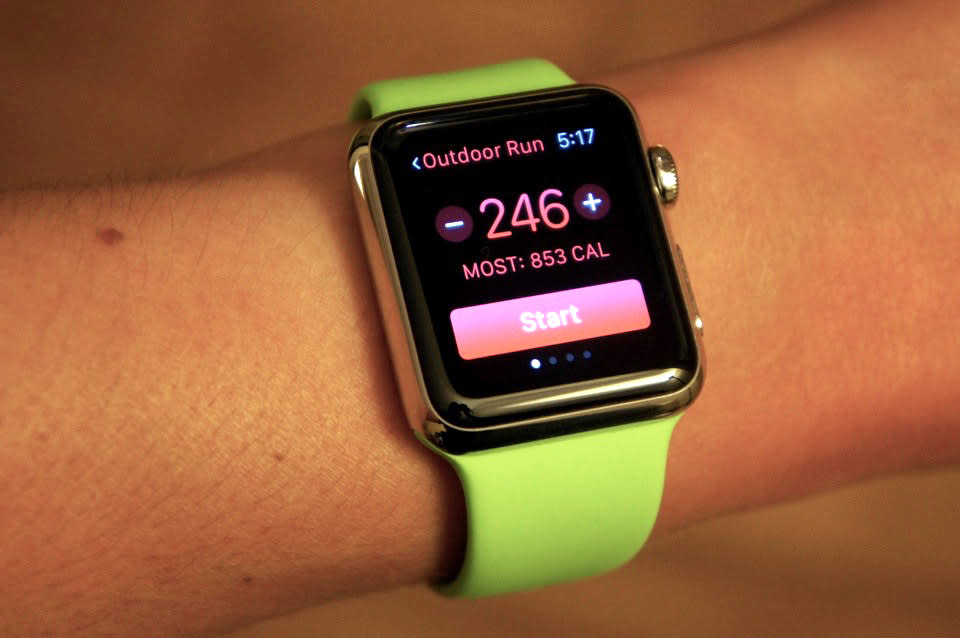
I was supposed to review the Apple Watch. That was the plan, but then, when Engadget had its first chance to test the device, I was on vacation. Specifically, I was in France, where I ran the Paris Marathon, my sixth 26.2-mile race in five years. As it happens, our Editor-in-Chief Michael wrote a fair, thorough review on his own, and he cut a fine figure in that stop-motion walkthrough video, too. If there's one thing he didn't go into detail on, though, it was the Apple Watch's performance as a fitness device. Some background there: Michael is one of those naturally skinny people with a stupidly fast metabolism who doesn't need to work out to stay trim. Which is a good thing, because he hates working out. That's why, when I finally had the chance to try out the Apple Watch myself (a $649 stainless steel model), I chose to focus on its abilities as a fitness gadget -- a fitting decision, considering my running habit was what kept me from reviewing the watch in the first place.
Getting started
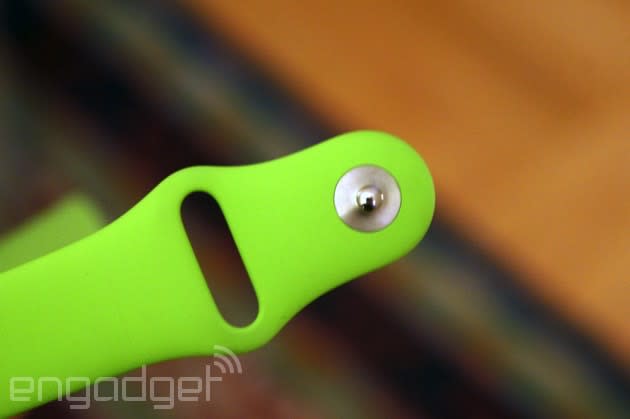
Let's pretend you haven't actually purchased the watch yet. If you're an athlete, you'll want the silicone sport strap, though you don't technically need it. That said, I always took the time to swap in my bright green sport band, even though the process of changing the strap can feel a bit tedious. For starters, although the Milanese loop stayed put while I was running (and proved sweat-resistant too), I could feel it coming loose while I engaged in activities that required more vigorous use of my arms -- things like kickboxing and burpees. It never fell off, thank goodness, but there were times during those workouts when I would stop to readjust the band before carrying on with whatever I was doing. Meanwhile, the sport version fastens securely, and its soft, rubbery finish feels comfortable against the skin. Which is good, because I really, really don't need another chafing injury.
From there, you don't even need to open the pre-loaded Workout app; if you didn't care about your distance or pace per mile, you could just start running and the watch would automatically detect that you were exercising, and calculate your calorie burn accordingly. (You'd also get credit for your exercise time in the watch's fitness-tracking Health app.) That said, I do care about pace and distance, and I suspect any self-described runner does, too. At the very least, you care how long you ran, right? To get any of those metrics, you will indeed need to use the Workout application.
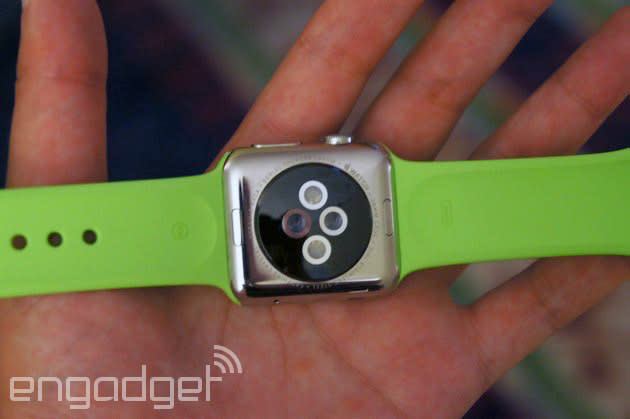
Open it up, and you'll see options for different kinds of workouts: indoor running, outdoor running, the elliptical and what have you. (There's also a miscellaneous "Other" category that's well-suited to sports like yoga and circuit training.) If I wanted to, I could cap my run at a certain distance or time limit -- say, two miles, or 20 minutes. And for most people, that should be enough. It so happens, though, that I'm a bit of a special case: I follow a run-walk routine, wherein I run for a few minutes and then take a short walking break before starting up again. Because of that, I prefer watches with a timed interval feature so that the device can beep at me when it's time to slow down or pick up the pace. The Apple Watch doesn't do that, at least not without the help of third-party apps. Indeed, various apps can keep track of your intervals without you constantly having to keep an eye on the clock.
The catch is that you need your phone nearby for them to work -- at least for now. That's because third-party apps currently don't have access to any of the watch's built-in sensors (the accelerometer, heart rate monitor, etc.), which means these apps have to rely on the phone to get their data. That's changing, though: Apple has said that third-party apps will gain access to the watch's sensors sometime this year. That will be good news indeed, although I still hope Apple will consider adding a run-walk mode in a future software update. It's true, I'm probably outnumbered by "regular" runners who rarely stop to walk, but I know I'm not the only one of my kind. In particular, run-walking is popular among beginners and casual runners -- ya know, precisely the sort of folks who are likely to use the Apple Watch over a dedicated running device in the first place.
Going the distance
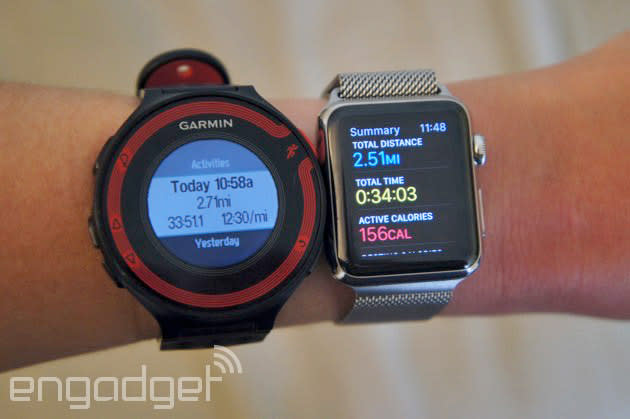
The Apple Watch and Garmin Forerunner 220 could never agree on how far I ran. The gap was especially big when I ran without my iPhone.
As it happens, I needed to carry my phone with me on my first few runs anyway. Everyone does. You see, the handset acts like training wheels of sorts, by using its various navigational sensors to help calibrate the watch's distance tracking. I didn't know that when I first unboxed the watch, and was a little dismayed to see that it miscalculated my usual route by about three-tenths of a mile off my Garmin 220, which actually does have built-in GPS for more accurate tracking. (By the way, this meant my pace was off by about 50 seconds, too). Things improved somewhat after I took the iPhone 6 with me for a few runs. When I ran a half marathon, the rated distance was also 0.18 mile off what my Garmin was reporting. Over the course of 13 miles, that comes out to an 11-second difference in my average pace. That's not nothing, of course, but it's a small enough variance that either way, I had an idea of how fast (or in my case, slow) I went.
Even now, though, after several weeks of testing, the distance tracking is still off, with the Apple Watch often telling me I went farther than I know I went. Also, I've noticed that while the Apple Watch and Garmin might start out neck and neck in terms of distance, the two start to diverge whenever I follow a route that takes me under a thick canopy of trees. Even with my phone nearby, the Apple Watch seems to struggle more in lower-signal areas. On one recent run, I observed a 0.12-mile difference between the Apple Watch and my Garmin, which over four miles comes out to a roughly 20-second difference in my pace. And mind you, that was with my iPhone in tow. When I tried going for another run without my phone, the distance gap ballooned to nearly four-tenths of a mile, which for a three-miler translated to a 1:24 difference in pace. That's huge -- and unacceptable. Even weirder, though? Garmin and Apple gave me nearly identical calorie-burn estimates for that same run, and almost every other workout, too. Huh.
A nice piece of kit
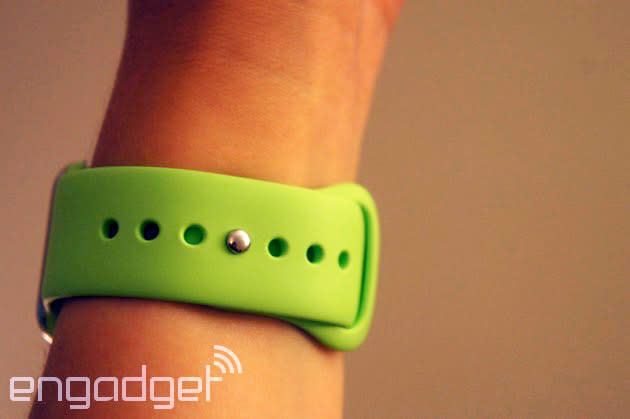
All that said, the Apple Watch is still a nice piece of hardware, especially for a first-generation device. Aside from being very well-crafted and pretty to look at, the battery life was longer than I expected -- and that's even after reading early reviews. I typically had no problem making it through a long day, even one bookended with an early-morning workout and after-work drinks. As I type this, I've been wearing the watch for seven hours, and still have 71 percent left. And that's despite the fact that I did a 75-minute workout this morning and have been periodically checking notifications. As for that recent half marathon, it was a long race indeed -- nearly three hours -- and I still had plenty of battery life left after I finished. If you think you'll need even more juice (say, during a full marathon), there's a power-saving mode allowing you to disable heart rate tracking during workouts. I would happily trade heart rate data for longer runtime, and indeed have made this feature my default. Still, I'm sure heart rate readouts will be non-negotiable for at least a few of you.
The Apple Watch is a nice piece of hardware, especially for a first-generation device.
If anything, my concern with regards to battery life is that the inductive charger comes loose from the device a little too easily, meaning runners might one day have their worst nightmare come true: waking up the day of the race to find their watch didn't charge overnight. Fortunately, the fitness gods cooperated with me the day of my half marathon; I woke up to a 100 percent charge, as planned. But there was at least one day when I woke up to find I only had enough charge for an early-morning bootcamp class. The watch was dead by the time I arrived at work, a little before 9AM. If I ever do buy an Apple Watch of my own, I'll be sure to get a spare charger to go with it. I'll keep it at my office, for days like that when bad luck strikes.
As for durability, the sapphire screen on my stainless steel edition remains free of scratches, as promised, although the casing and Milanese band haven't fared quite as well; both have picked up small dings in the weeks I've been testing this. I've also taken it in the shower with me, and even got stuck in a downpour the day of my half marathon; both the watch and sport band survived. By the way, the reason Apple is careful to call the watch water-resistant instead of waterproof is that it can't guarantee the device will be okay if you go swimming or even spend time in a sauna. So I've refrained from doing those things -- it's not like Apple didn't warn us, right? If, however, you want a little vicarious thrill, fitness nut DC Rainmaker took the watch for a 1,000-meter swim and a jump off a high-dive platform, and the device is still ticking. You can read his review here.
Growing pains
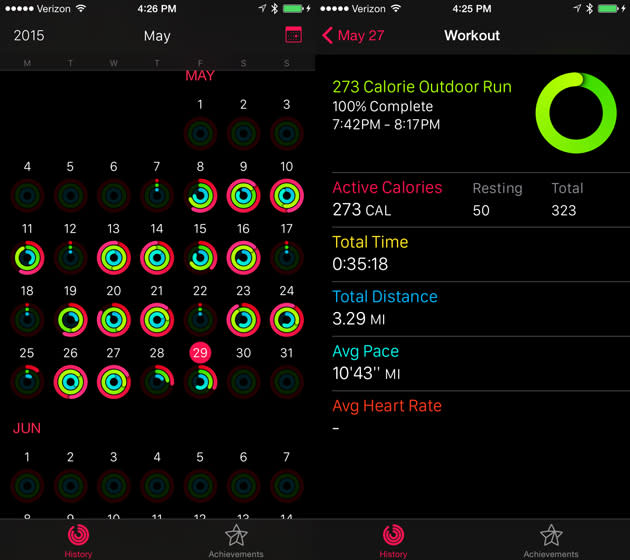
So I generally like the hardware. But the software could use work. It's not just the fact that there's no run-walk mode, either. It's other things: some big, some small. For instance, there's no intuitive way to review past workouts. Compare that to other workout apps, like RunKeeper, Garmin Connect and Strava, which have a long activity feed you can browse through, making it easier to see how your performance has changed over time.
While I'm on the subject, I wish I could export full workouts to other apps, which is something Garmin and others let me do. I can export to Apple Health, where I can then send my data to certain compatible apps, like Garmin. Even then, I'm not preserving an archive of workouts, per se; I can only go back and look at how many steps I took the whole day. Fortunately, at least, some of the apps I've paired with Apple Health can talk to an even wider range of applications. So, while it might not be possible to send my Apple Watch data directly to MyFitnessPal, I can at least send that information to Garmin, which will send it to MyFitnessPal. Again, full workouts aren't preserved, but at least my other fitness and nutrition apps know how many calories I burn in a day. That's something.
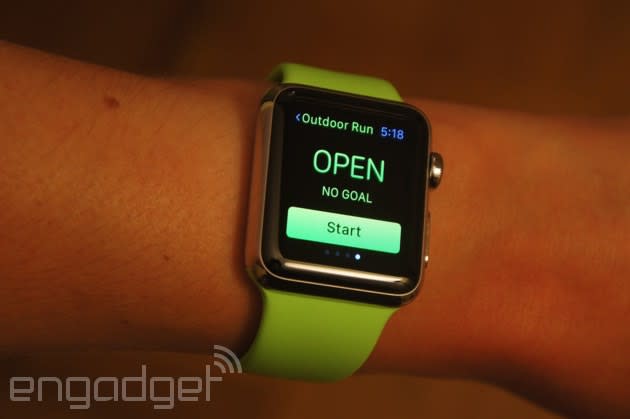
In use, I still find it annoying to hit the pause button on a workout, to the point where I avoid doing so unless I'm actually done exercising. My options are: Either do a long-press ("Force Touch") on the screen and then tap again when I see a pause button, or swipe all the way to the left while the stopwatch is running, and then hit pause. Both ways feel clumsy. I don't like how the Force Touch option involves tapping twice (three times, if you count hitting the "end" button to stop the timer). But if I swipe left on the screen instead, I often hit something else by accident, and end up, say, toggling the time and time elapsed. It's so much easier to just hit a physical button on my Garmin, as I would with an old-school stopwatch. That said, I can see where it would be problematic to use the Apple Watch's home button that way; that's also what you use to open the app menu. Still, what if there was an option to use the home button like a stopwatch while a workout was in progress?
Speaking of the sort, I wish there were a "Do Not Disturb mode" for workouts, where I could automatically suspend notifications while working out. Indeed, there were times I stopped to walk, lifted my wrist to check my distance and saw Gmail notifications on the screen instead. I'm sure some athletes actually prefer it this way, but it would be nice to have the option of just shutting everything out while I'm in my running zone.
A bright spot
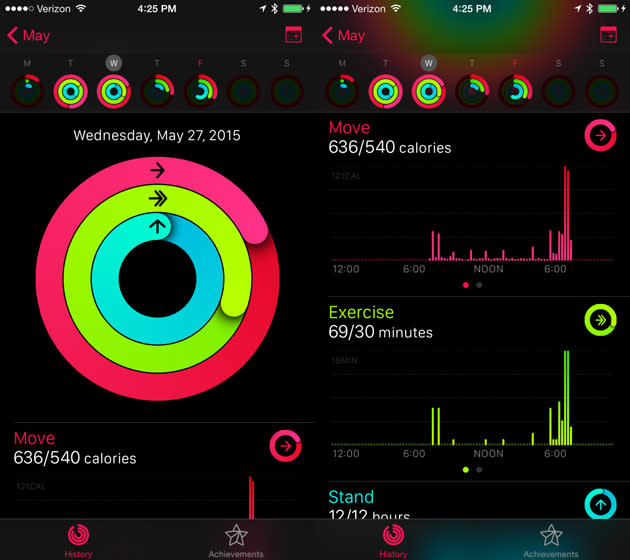
While the Workout app needs polish, there is a bright spot, and that's the separate Activity app, mirrored on the watch itself as well as the iPhone. The Apple Watch may be limited as a running gadget, but it makes an excellent fitness tracker. Part of it's that Apple puts fitness in terms I can understand -- namely, it tracks my calorie burn, minutes spent exercising and whether I got up to move regularly. That's more useful than knowing how many steps you took, no? Each person's goals are customizable, but whatever yours are, the app layout is the same: You'll see your progress represented in three concentric rings, each with a different color: pink for calories, yellow for exercise and blue for standing time.
Additionally, you can view a basic graph showing when throughout the day you were active (or inactive, as it were.) Each time you check the app, you'll see those rings fill up before your eyes, representing the activity you've done since you last checked in. Meet your goal, and the ring will completely fill up, and even overlap on itself if you've been an overachiever. Meet your goals consistently -- like, every day for a week -- and you'll unlock a bevy of awards, not unlike the badges you get on Foursquare.
I don't know what it is -- the color-coding, the awards, the occasional notification nudging me to keep going -- but I find this design highly compelling. In fact, I would go so far as to say the Activity app is my favorite thing about the Apple Watch, aside from the stylish hardware. On the rare day I forgot to put on the watch when I left for work, it was the Activity app I missed most; I wasn't going to get credit for all my moving, and that was a shame. Otherwise, for the most part, I didn't fiddle much with the watch in day-to-day use; occasionally a notification would come in and I would check it, but for much of the day, the watch just sat on my wrist; little more than a high-tech piece of jewelry. With the Activity app, though, the watch often felt like a really nice fitness tracker; one that, unlike competing products, I actually liked enough to wear every day.
Who should buy this?
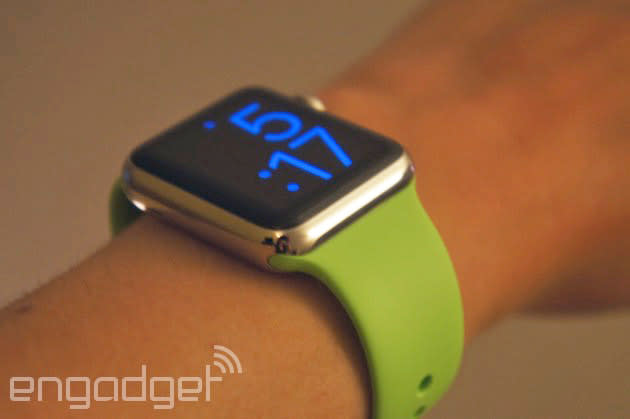
The problem, of course, is that even at $349, the entry-level price, it's one expensive fitness tracker. And while it has a top-notch app, it still lacks some features the competition offers, like sleep tracking. Meanwhile, serious runners will be better served by a dedicated running watch, many of which cost somewhere in the $200 range. Then again, Apple's watch is more stylish than what Fitbit or even Jawbone are selling, and it also does smartphone notifications, which most of its rivals don't.
Is it too expensive? At $349, not necessarily.
So is it too expensive? At $349, not necessarily. But at $649, the price I would have paid for my test unit, maybe. As Michael said in his review, it depends how much you like the design; how much of a watch person you are; how much status symbols even matter to you. As for me, I won't be trading in my Garmin just yet, and I probably won't be laying out $649 of my own money to buy an Apple Watch. It's a lot to spend on a device that mostly just sits on my wrist, but I also wouldn't want to settle for the cheaper $349 model because I really do prefer the pricier stainless steel edition. But if someone wanted to get me one as a gift, I'd be most appreciative -- both for the pretty design and the Activity app. For me, the Apple Watch is impractical, at least at this price. Even in its first iteration, though, it's a great fitness tracker and has the potential to one day be a good running watch. But it won't be until Apple lowers the price (or comes out with an improved model) that more people will be willing to try it out for themselves.


































































